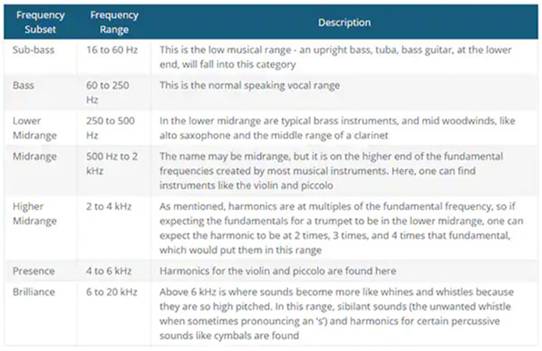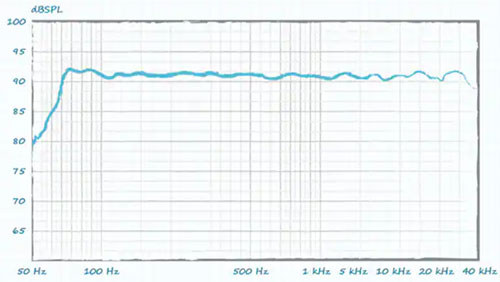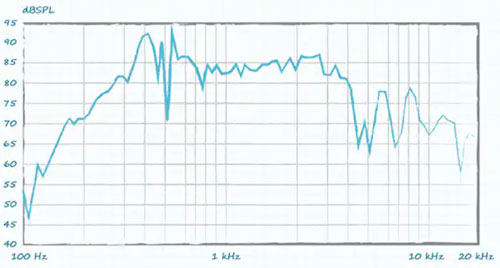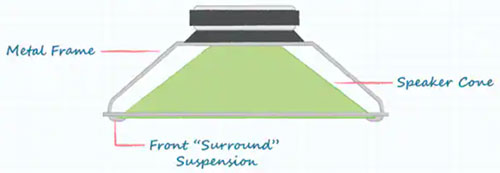了解音频频率范围和音频元器件
发布日期:2022-02-23
点击次数:2289
作者:Jeff Smoot 是 CUI Devices 应用工程和运动控制部门副总裁
从汽车到家庭再到便携式设备,音频无处不在,而且其应用只会越来越广。当涉及到音频系统设计时,尺寸、成本和质量是需要考虑的重要因素。影响质量的变化因素很多,但通常归结为针对给定设计重新构建必要音频的系统能力。在本文中,我们将了解更多关于音频范围及其子集的基础知识、外壳设计的影响,以及如何根据应用确定其可能需要的音频范围。
音频范围的基础知识
20 Hz 至 20,000 Hz 是常用音频参考范围。然而,普通人能听到的音频不超过 20 Hz 至 20 kHz,而且随着年龄的增长,这个可探测的范围还会持续缩小。通过音乐对音频的理解最为透彻。在音乐中,每一个随后的八度音都会使频率翻倍。钢琴的最低音 A 大约是 27 Hz,而最高音 C 则接近 4186 Hz。除这些常见频率之外,任何产生声音的物体或设备也会产生谐波频率。这些只是在较低振幅下的较高频率。例如,钢琴的 27 Hz“A”音也会产生 54 Hz 的谐波,81 Hz 的谐波,以此类推,每个谐波都比上一个更安静。在需要准确再现音源的高保真扬声器系统中,谐波将变得尤为重要。
音频的子集
下表列出了 20 Hz 至 20,000 Hz 频谱内的七个频率子集,这有助于定义音频系统设计中使用的目标范围。

表 1:音频子集范围。(图片来源:CUI Devices)
频响图
频响图是直观了解蜂鸣器、麦克风或扬声器如何再现各种音频的好方法。由于蜂鸣器在一般情况下只输出可听音调,因此通常具有较窄的频率范围。另一方面,扬声器通常具有更宽的频率范围,因为扬声器通常用来重现声音和语音。
如扬声器、蜂鸣器等音频输出设备的频响图 Y 轴以声压级分贝 (dB SPL) 为单位,这根本上是设备的响度。音频输入设备的 Y 轴,如麦克风,则是以分贝为单位表示灵敏度,因为它们用于检测声音而不是产生声音。在下面的图 1 中,X 轴代表频率的对数刻度,Y 轴以分贝声压级列出,因此这是一个音频输出设备的图表。注意,因为 dBs 也是用对数表示,所以两个轴都用对数表示。

该图表示在不同频率下输入恒定的功率会产生多少分贝的声压级,该图相对平坦,整个频谱范围内的变化最小。除了 70 Hz 以下的部分急剧下降外,该音频设备在相同输入功率下,会在 20 Hz 和 70 kHz 范围内产生稳定的声压级。任何低于 70 Hz 的设备都会产生较低的
声压级 (SPL) 输出。
例如,CUI Devices 的 CSS-50508N 扬声器频响图(图 2)较好地说明了更典型的扬声器属性。该图包括不同的峰值和谷值,表示共振加强或减少输出的点。这款 41 mm × 41 mm 扬声器的规格书列出了 380 Hz±76 Hz 的共振频率,可以看作是频响图上的第一个主峰值。这在 600 Hz 至 700 Hz 左右迅速下降,但随后从大约 800 Hz 至 3000 Hz 之间达到稳定的声压级性能。由于扬声器的尺寸,设计者可推测 CSS-50508N 在低频范围内的表现不会超过高频范围,这一点在图中得到了证实。通过了解如何以及何时参考频响图,设计工程师可以确定扬声器或其他输出设备是否能够再现其目标频率。

图 2:CUI Devices 的 CSS-50508N 41 mm x 41 mm 扬声器频响图。(图片来源:CUI Devices)
音频范围和外壳的注意事项
音频范围会在几个方面影响外壳设计,如下文所述。
扬声器尺寸
与大型扬声器相比,小尺寸扬声器的移动速度更快,使其能够在较少不必要谐波的情况下产生更高的频率。然而,当试图在较低频率下实现类似 SPL 输出时,就需要更大型的扬声器膜片来移动足够的空气,以便匹配与较高音调相同的感知 dB SPL。虽然较大的振膜要重得多,但在低频时通常不会造成问题,因为其移动速度很慢。
使用较小还是较大的扬声器最终将取决于应用需求,但较小的扬声器通常只需要较小的外壳,以降低成本、节省空间。浏览 CUI Devices 的博客,详细了解如何设计微型扬声器外壳。
共振频率
共振频率代表一个物体的自然振动频率。拨动吉他琴弦时,琴弦以其共振频率振动。这就是说,如果将扬声器放在吉他旁边并播放琴弦的共振频率,吉他琴弦就会开始振动,且振幅随着时间的推移增大。然而,当涉及到音频时,这种现象也会导致与周围物体产生不必要的异常声音。CUI Devices 关于共振及共振频率的博客就该主题提供了的更多信息。
为了避免扬声器同时具有非线性输出和不必要的谐波,在外壳设计中确认自然共振频率与预期的音频输出不在同一频谱范围内就显得尤其重要。
材料权衡
扬声器和麦克风设计在那些必须在移动期间保持静止、柔性和刚性的组件之间达到微妙的平衡。扬声器振膜(或纸盆)应很轻,以便快速响应,同时尽可能保持刚性,以防移动时发生变形。CUI Devices 的扬声器通常采用重量轻、质地硬的纸和麦拉膜。麦拉膜是塑料的一种,还具有防潮和防湿的优势。除了膜片外,还采用橡胶连接膜片和框架。为了防止在极端移动情况下发生断裂,这种材料必须既坚固又柔韧,从而不会限制膜片的移动。

图 3:扬声器的基本构造。(图片来源:CUI Devices)
在比较麦克风技术时也可以看到相同的元器件之间的权衡。驻极体电容式麦克风和 MEMS 麦克风耐用性好、封装紧凑和功耗低,但频率和灵敏度更为有限。另一方面,带状话筒具有更好的灵敏度和频率范围,但同时也牺牲了耐用性。
材料也是外壳设计中的一个重要选择,会影响声音的共振和吸收。外壳的主要目标是抑制后方产生的非相位的声音,这意味着所选材料必须能有效地吸音。这在难以抑制非相位声音的较低频声音应用中尤其关键。
结语
归根结底,音频系统的数量有限,没有一个单独的音频输出设备能够以任何保真度跨越整个音频频谱。一般来说,大多数应用不需要这种保真度,而且可能不需要完全的线性输出。在为一个设计选择合适的音频组件时,了解音频频率范围仍将具有重要的作用。有了这种认识,工程师可以更好地在成本、尺寸和性能之间的进行权衡。CUI Devices 提供一系列频率范围不同的音频解决方案,以支持全套应用。
|
免责声明: 本文章转自其它平台,并不代表本站观点及立场。若有侵权或异议,请联系我们删除。谢谢! |










